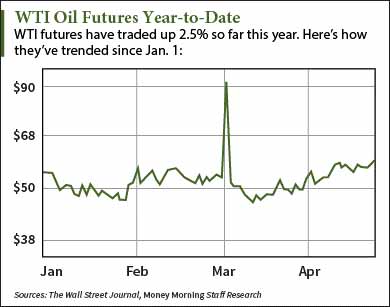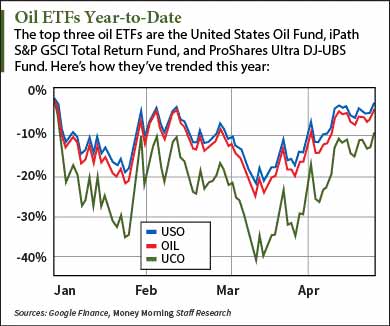 Fewer investors than in years past are investing in oil right now since oil prices have plummeted 41.8% since June. But oil has rebounded 11.4% in the last month. The S&P Crude Oil Index - which dropped 42% in the last year - saw a single-day gain of 2.5% yesterday (Wednesday).
Fewer investors than in years past are investing in oil right now since oil prices have plummeted 41.8% since June. But oil has rebounded 11.4% in the last month. The S&P Crude Oil Index - which dropped 42% in the last year - saw a single-day gain of 2.5% yesterday (Wednesday).
According to Money Morning Global Energy Strategist Dr. Kent Moors, prices will recover in the long term. He expects them to be in the $60 to $73 range by mid-July.
This means not investing in oil will cut you off from profits.
Many investors think a popular oil exchange-traded fund is the best way to invest in oil, but that's only a small part of the story.
For anyone who wants to get a piece of this price rebound, here are two different ways to begin investing in oil as it moves higher in 2015...
Investing in Oil Method No. 1: Futures
 The most direct method of investing in oil is purchasing futures.
The most direct method of investing in oil is purchasing futures.
An oil future is a contract obligating the buyer to purchase a specific quantity of oil at a future date and price. Oil futures are grounded in speculation due to sellers predicting oil prices months in advance.
Oil futures for June 2015 delivery trade near $58 as of April 29. Say, for example, that oil is available for $63 in a futures contract dated to come due in June 2016. A speculator who thinks the price will zoom past that to $73 by June 2016 can buy the contract at $63.
If the speculator is correct and the price hits $73, he/she can buy oil at $63 and sell it for a $10 profit. If oil falls short of $63, the contract is worthless - and all the speculator did was guarantee he/she would buy oil for $63 down the road.
It's clear that investing in oil futures has no shortage of risk. They're volatile because they're heavily influenced by other traders.
Trading oil futures is too risky for many investors. If you're one of them, check out this safer way of investing in oil today...
Investing in Oil Method No. 2: Exchange-Traded Funds (ETFs)
 The second way to start directly investing in oil is buying oil ETFs.
The second way to start directly investing in oil is buying oil ETFs.
Many oil ETFs track the performance of indexes that follow prices or a specific group of energy. For example, some mostly invest in oil field services stocks, while others focus on drillers. Some ETFs track and physically store oil while others invest in futures contracts.
Despite different structures, all oil ETFs trade on a stock exchange. They can be bought and sold like regular stocks.
The popularity of oil ETFs has skyrocketed. Since they're designed to follow oil, they offer broad exposure to the commodity without the hassle of purchasing futures contracts.
The most popular one is the United States Oil ETF (NYSE Arca: USO). The fund has nearly $2 billion in assets and has jumped 14.4% since March 30 - but don't be lured in by the gains. USO seriously limits investors' returns due to the current contango in prices.
Now that you know your options for investing in oil, let's answer the big question...
What Is the Best Way to Start Investing in Oil?
In the current low price environment, an ETF is a safer bet than futures contracts. One of the most profitable ETFs to buy today is one that holds a basket of midstream master limited partnership (MLP) stocks.
Midstream MLPs are "marketproof" because they derive half of their revenue from infrastructure such as pipelines and storage facilities. They remain profitable as long as the oil keeps flowing. Low oil prices don't have as large of an effect on these MLPs as they do on other energy stocks.
That's why we like the First Trust North American Energy Infrastructure Fund (NYSE Arca: EMLP). It holds 68 stocks that represent a wide spectrum of MLPs and energy companies headquartered in the U.S. and Canada.
[epom key="ddec3ef33420ef7c9964a4695c349764" redirect="" sourceid="" imported="false"]
The fund became the first actively managed ETF to reach over $1 billion in assets. Morningstar Inc. (Nasdaq: MORN) reported it had the best one-year total return out of the 24 "equity energy" ETFs in 2014.
EMLP is also about to soar from the biggest MLP merger this year. In January, Energy Transfer Partners LP (NYSE: ETP), EMLP's sixth-largest holding, acquired Regency Energy Partners (NYSE: RGP) in an $18 billion deal. The transaction is expected to close sometime this quarter.
Once that happens, ETP's $32 billion market cap will make it the second-largest MLP on the market. EMLP is the juiciest pick for investors looking to benefit from the M&A activity rocking the energy landscape.
Bonus Content: You can make 2015 your wealthiest year in a few simple moves. You just need to know the three common investing habits to dump immediately, the single most effective strategy for your portfolio, and five stocks to get you started to a wealthier you. Get all of that right now in this exclusive guide...
More thoughts on investing in oil? Talk to us on Twitter at @AlexMcGuire92 and @moneymorning.


